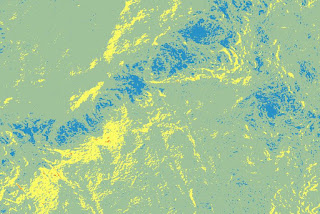My name is Ben Geyman and I’m a junior at Bowdoin
College studying Earth and Oceanographic Science. I grew up in Seattle, Washington.
 |
| Snapshot of roughness in Watershed 3. Smooth ridgetops are shown in blue and the rough, jumbled bedrock transition is shown in yellow downslope. |
This summer I’m investigating the transition from
bedrock outcrops to shallow soils near the upper watershed boundaries and am
taking the Hydropedologic gospel from Dr. Scott Bailey. My hope is that I can identify a distinct topographic
roughness signature of shallow-to-bedrock zones using GIS metrics in order to
better predict the spatial distribution of shallow-to-bedrock soils. Basically, it’s hard to know where bedrock is
unless you can see it in the field, so I’m hoping to find an easy way to detect
it with hillshade and elevation maps.
These shallow-to-bedrock areas are important because they export high
amounts of dissolved organic carbon and are key sites of nitrification.
In order to relate roughness and soil depth, I’m digging
a lot of holes. On a good day, I might
stick a metal probe into the ground a hundred times to record the “depth to
refusal” by rock, root or a hard pan of till.
Along the way, I’m hoping to characterize the variability in soil units
in this region. To do this, I dig small
holes to identify different horizons in the soil profile and characterize the
soils as one of five distinct hydropedologic units.
Here’s a picture of a typical podzol, one of the
most common soil units at Hubbard Brook.
You can see the organic “O” horizon on top, a gray “E” horizon leached
of organic compounds and metal ions below, and brown and red mineral “B”
horizons where organic and metal compounds are re-deposited below. The photo isn’t very good, but profiles can
be pretty beautiful.
At the end of the day, it’s always nice to come back
to Pleasant View. I start nearly every
day looking at the plants in our garden with coffee and I end pretty much every
day watching plants with a beer. I do a lot more watching than weeding, so the
plants don’t always look great. This
year we have corn, squash, peas, beans, lettuces, chard, carrots, tomatoes and
peppers. We also have a 7-foot tall
monster rhubarb.
On weekends, I’ve been enjoying hiking around Franconia
and the Presidentials. When it’s hot, I
suspend my fear of fish and nothing is better than swimming in Mirror
Lake. One highlight was when Geoff took
me climbing on a weekday after work. We went up to the Eaglet in Franconia,
supposedly the tallest freestanding spire in the NE.
Sometimes I lose perspective when I’m digging holes
in heat, humidity and swarms of blackflies. I question whether I’m collecting
enough data, whether these data will produce any results, and whether any of it
matters. Then I have a panic attack
because I think I feel a tick crawling on my back. But most of the time I am really happy
here. Dr. Bailey has a lifetime’s worth
of knowledge and I learn something new every time I go into the forest with
him. Hubbard Brook has an amazing tradition
of research and a big part of it is living with interesting people in Pleasant
View Farm.



No comments:
Post a Comment